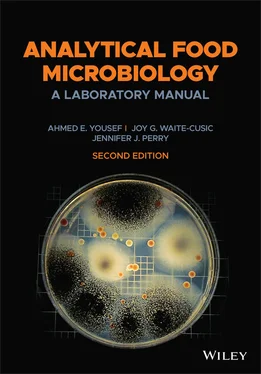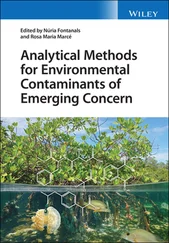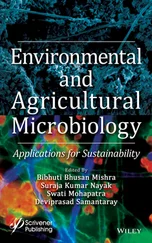1 Dell, R.B., Holleran, S., and Ramakrishnan, R. (2002). Sample size determination. ILAR Journal 43: 207–213.
2 Food and Drug Administration (FDA). (2017). Draft guidance for industry: Control of Listeria monocytogenes in ready‐to‐eat foods. Docket Number: FDA‐2008‐D‐0096. Washington, DC: FDA.
3 International Commission on Microbiological Specifications for Foods (ICMSF). (1986). Microorganisms in Foods 2. Sampling for Microbiological Analysis: Principles and Specific Applications. 2e. Oxford, UK: Blackwell Scientific Publications.
4 Moberg, L. and Kornacki, J.L. (2015). Microbiological monitoring of the food processing environment. In: Compendium of Methods for the Microbiological Examination of Foods, 5e. (ed. Y. Salfinger and M.L. Tortorella), 27–43. Washington, DC: APHA Press.
PRACTICING SAMPLING AND SAMPLE PREPARATION
Accurate sampling, careful sample handling, and diligent preparation of sample for analysis are critical measures for successful recovery of microorganisms from food. Factors to consider during sampling and sample preparation have been described in the first section of this chapter. These factors should be reviewed carefully before starting this exercise. Students also should prepare, in advance, an exercise summary that includes a sample preparation approach specific to the food assigned to them. The single‐sheet summary will be used on the bench as a guide while executing the exercise.
Practice sampling of food and preparing the sample for microbiological analysis.
Students will work in groups (two students per group). Each group will be assigned a food sample to prepare for a typical microbiological analysis. Ahead of the laboratory session, each group will be informed of the food sample assigned and members of the group are asked to prepare an exercise summary that includes a sample preparation approach specific to the food assigned to their group. Examples of foods to be provided are heads of iceberg or Romaine lettuce, and whole fish (e.g., tilapia). Members of each group will prepare their laboratory sample for analysis, withdraw two 10‐g analytical samples, homogenize the samples, and prepare three decimal dilutions of each homogenate. Students will be evaluated on the basis of work efficiency, aseptic technique, accuracy of measurements, and ability to work cooperatively within the group.
MATERIALS
Per Group of Two
Sterile peptone water (diluent):Two bottles, 90 ml eachSix test tubes, 9 ml each
Food sample (laboratory sample)One of the following foods: iceberg lettuce, Romaine lettuce, whole fish, cantaloupe, etc.
PipettesOne 1000‐μl automatic pipetter and a box of compatible sterile tipsTwo 1‐ml individually wrapped sterile serological pipettes, and two pipetting aids
Top‐loading balance
Stomacher and stomacher bags
Sample preparation equipment (equipment is to be cleaned and sanitized with ethanol, from an alcohol squeeze bottle, between uses)
Cutting board
Knife and a pair of scissors
Spatula and pair of tongs
Two aluminum‐covered sterile beakers: 250‐ml or 400‐ml capacity, depending on sample assigned
Important Notes:
Aseptic technique is expected in this and all other exercises. This includes, but is not limited to working in proximity of a lit Bunsen burner, flaming the mouth of the medium container after removing the cap, protecting the sample during processing against contamination from the work environment or the analysts, and using common sense in handling sterile and contaminated tools.
Wearing gloves and goggles is needed for personal safety.
1 Safety and Laboratory Etiquette ComplianceRead and follow laboratory safety guidelines described in Chapter 1.Give special attention to the “practical aspects” described in that chapter.
2 Sample InformationPick the food sample assigned to the group.Record any pertinent sample information.
3 Sample Cutting (group task)Using the plan prepared by the group in advance, cut the food sample (laboratory sample) into small pieces suitable for withdrawing 10‐g analytical samples. Use the appropriate sample preparation equipment provided.Note: The analytical sample should represent the laboratory sample accurately.
4 Withdrawing the Analytical Sample (individual task: one sample per group member)Using the sterile beaker, weigh out one 10‐g analytical sample.Aseptically transfer the analytical sample from the beaker into a sterile stomacher bag.
5 Homogenization (individual task)Add the 90‐ml diluent to the contents of the stomacher bag. Carefully push most of the air out of the bag and close the bag with the provided fastener before stomaching.Homogenize the sample in the stomacher for two min. The contents of the stomacher bag (i.e., the homogenized sample) is the 1/10 (10–1) dilution of the original analytical sample.
6 Preparing Decimal Dilutions (individual task, see Figure 2.3)Label three dilution tubes that will become the 10–2, 10–3, and 10–4 dilutions.Using the serological pipette, transfer 1 ml of food homogenate into the diluent tube labeled 10–2. Vortex tube contents briefly.Using the automatic pipetter, transfer 1 ml of the 10–2 tube into the tube labeled 10–3. Vortex tube contents briefly.Using the automatic pipetter, transfer 1 ml of the 10–3 tube into the tube labeled 10–4. Vortex tube contents briefly.
7 Recording Observations (group task)Report work progress to instructor.
1 How similar or different is the sample preparation scheme you wrote from the one you executed? If you encountered irregularities, how do you plan to overcome these in future laboratory exercises?
2 A batch of alfalfa sprouts was produced by company A and temporarily stored in a walk‐in refrigerator before shipping to a retail grocery store (company B). The lot is made of 1500 cardboard packages, each containing 250 g of sprouts. The criterion for acceptance or rejection of the sprouts by company B is based on the percentage of packages positive for coliforms. Company A claims their shipments will have no more than 5% of the packages positive for coliforms, and company B decided to reject any shipment when 10% (or more) of its packages are positive for coliforms. You were asked to develop a sampling plan, analyze the lot, and determine statistically if it will be accepted or rejected. To assist in developing this plan, answer the following:Determine the number of samples that should be analyzed to produce 80% statistical power.Determine the number of samples that should be analyzed to produce only 50% statistical power.Considering the large number of samples that needs to be analyzed, what could you do to decrease the number of samples analyzed yet still produce meaningful results that help company B accept or reject the lot?
CHAPTER 3 ENUMERATION OF MICROORGANISMS IN FOOD: DILUTION SERIES. COLONY COUNTING. MOST PROBABLE NUMBER.
INTRODUCTION
How can one evaluate the microbiological quality of a food? Enumeration of microorganisms in the food is the answer that often comes to mind. The important follow up question then is: Can this enumeration be done accurately so that the results are used reliably to measure the microbiological quality? Reliability of the results, obviously, depends on how the enumeration is executed. This chapter addresses this topic with the goal of familiarizing the analysts with the methods and techniques used in enumeration and helping them apply these to produce repeatable and reliably results.
Читать дальше












